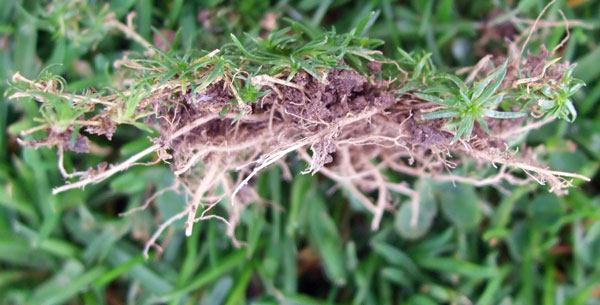 Botanical name:Sagina procumbens
Botanical name:Sagina procumbens
Family: Caryophyllaceae
Aliases: bird-eye pearlwort, prostate pearlwort
General information
Procumbent pearlwort is a low growing perennial weed, which can be a major nuisance in fine turf and luxury lawns, if it is allowed to spread.
It tolerates very close mowing and is often found in golf and bowling greens, especially where the sward has become thin.
This weed forms a tight mat in managed turf and is often difficult to recognise to non-professionals, in some cases it has been mistaken for moss.
It will also grow in borders, waste ground, in fact anywhere where the soil is exposed. Pearlwort is wear tolerant weed and can often be found growing in the cracks of pavements and slabs. It is very popular as a ground cover plant in landscape gardening.
This weed favours moist soil conditions and is often found in frequently irrigated turf. It is common in coastal areas.
Given the right conditions pearlwort is capable of rapidly colonising turf. It spreads by runners via its branched rootstock and by seed, in fact many seeds are produced and are spread by mowers and foot traffic.
Procumbent Pearlwort Identification
- Leaves: Procumbent pearlwort has tiny blade like narrow leaves that are opposite, stalk-less with pointed tips. They have a thick cuticle, which helps this weed resist many herbicides. The leaves will grow between 10 – 20 mm in length.
- Flowers: The flowering period is between May to September. Pearlwort bears tiny, solitary flowers, each have 4 parted white/cream petals measuring from 2 to 4 mm. The flowers are found on long stems near the ends of the branches.
- Roots: The root system which is shallow and fibrous develops from nodes on the stems.
Procumbent Pearlwort Images (click image to enlarge)
More images and free downloads
Prevention and control
It is important to keep the turf in healthy condition with good lawn care practices. Correct feeding, aeration and mowing practices will help keep the grass sward thick and reduce the incidence of weeds. Avoid bare areas in turf, as they create an ideal seed bed for pearlwort.
Improving the surface drainage will help prevent procumbent pearlwort.
Avoid excessive irrigation, as this weed thrives in moist soil conditions.
Hand weeding can be effective in removing pearlwort. Act as soon as this weed is identified, once it establishes into larger patches it may prove to be a major headache. It is a difficult weed to control with selective weed killers.
A selective herbicide can be used for the control of pearlwort, but in most instances, more than one treatment will be required for satisfactory control. Always try and keep the use of chemicals down to a minimum by only treating the infected area.
Recommended chemicals for the control of procumbent pearlwort
2,4-D + Mecoprop-p
2,4-D + Dichlorprop-p
2,4-D + Dicamba
Mecoprop-p + Dicamba
Mecoprop-p + Fluroxypyr
Recommended products for pearlwort control
Professional products (The user requires the appropriate certificate/s to apply these products)
Headland Relay Turf (Mecoprop-p, Dicamba, MCPA)
React Ultra (Mecoprop-p, Dicamba, MCPA)
Bayer Longbow (Mecoprop-p, Dicamba, MCPA)
Barclay Holster XL (2,4-D, Fluroxypyr, Dicamba)
Mascot Crossbar (2,4-D, Flurosulam, Dicamba)
Products available for non-professional use (These products are available from garden centres and DIY stores)
Resolva lawn weed killer (2,4-D, Mecoprop-p, MCPA, Dicamba)
Doff lawn spot weeder (2,4-D, Mecoprop-p, Dichlorprop-p)





